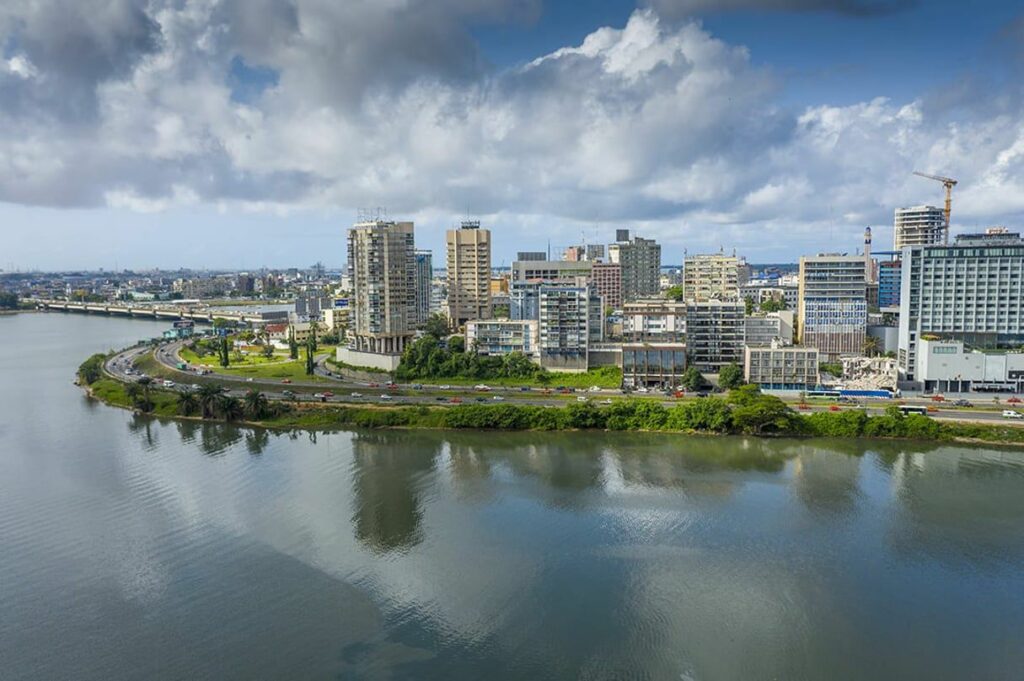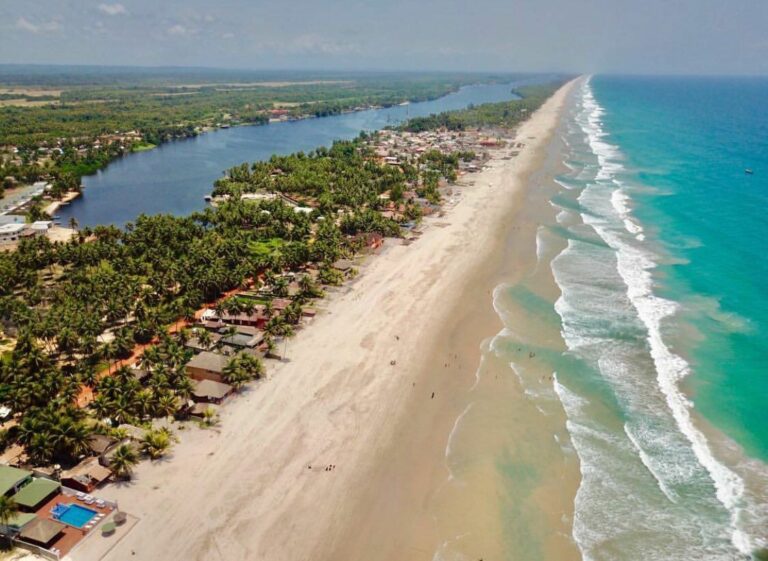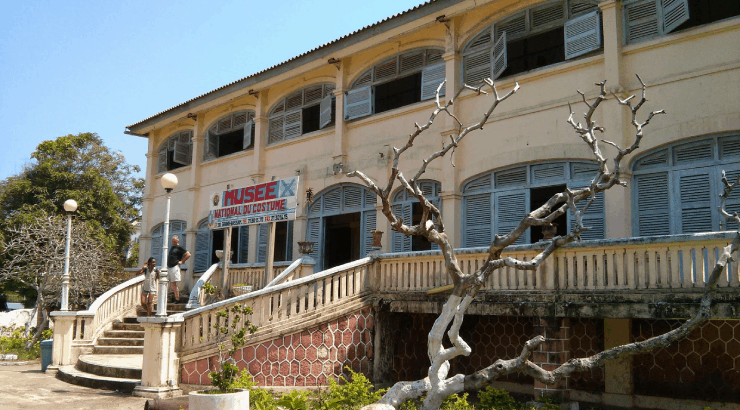
Located on the west coast of Africa, Ivory Coast is a multifaceted country rich in cultural and natural diversity. Its shape resembles a square of about 600 km on each side, covering an area of 322,463 km². With Yamoussoukro as its capital, it shares borders with Mali, Burkina Faso, Liberia, Guinea, and the Atlantic Ocean. According to Country Meters data, Ivory Coast’s current population is estimated at 29,133,965 inhabitants, with French as the official language, though nearly 70 other languages and dialects are spoken by the population. The country offers several forms of tourism, including cultural, coastal, historical, sports, religious tourism, and more.
So, if you’re looking for adventure, cultural discoveries, or relaxing moments, here are some destinations that are sure to captivate you.
1 - Assinie beach

Just 94 km east of Abidjan, the village of Assinie has transformed into a charming and popular seaside resort. Its long stretch of fine sandy beach, extending along a narrow lagoon strip bordering the Atlantic Ocean and Aby Lagoon, offers an idyllic setting for relaxation. Although the ocean waves can sometimes be strong, the beach generally has a gentle slope, perfect for swimming and having fun. Along the coast, you’ll find a variety of establishments, ranging from luxury hotels to more modest restaurants and clubs, allowing everyone to find something they enjoy. For those coming from Grand Bassam, a path along the beach will lead you directly to the various establishments all the way to Assouindé. Between Assouindé and Assinie, access to the beach is through a pleasant boat ride from the road that runs alongside Aby Lagoon to the north.
Assinie is truly the perfect spot to escape and enjoy the sun and sea, whether for a weekend getaway or a longer retreat.
2 - Banco national park

Nestled in the heart of Ivory Coast’s economic capital, Banco National Park covers an area of 3,438 hectares. Described as both a water reservoir and the green lung of Abidjan, this protected area since 1953 is a significant hub for environmental education.
The park’s name comes from the Ebrié expression “Gbancô,” which means “refreshing water source.” Indeed, a small river called Gbangbo flows year-round thanks to an artesian well. The park is home to 600 hectares of primary forest and an arboretum with over 800 species of plants native to tropical regions of Africa, Asia, and Latin America. You’ll see majestic kapok trees (Ceiba Pentandra), captivating with their giant roots and large size, as well as charming bamboo groves and trees with medicinal leaves like coca and aguia. The park also features fish ponds, a semi-natural swimming pool, a restaurant, and an eco-museum. During the visit, a guide will introduce you to the fruit of the Blighia sapida tree, which resembles a lychee encased in a shell, offering a surprising peanut-like taste.
Entry to the park is set at 5,000 CFA francs, with an additional fee of 10,000 CFA francs for a guide.
3 - The national museum of costume

Inaugurated in 1981, the National Museum of Costume is located in the “France” district of Grand-Bassam, within the former Governor’s Palace, which once served as the first capital of Ivory Coast from 1893 to 1900. Situated at the corner of Treich Laplène and Bonhoure boulevards, this well-preserved building is a remarkable example of prestigious architecture from that era. Built with prefabricated elements and a steel beam structure, it is distinguished by its beautiful wooden joinery.
The museum is surrounded by a 4,000 m² park, adorned with lawns, coconut trees, mango trees, and fig trees, providing a pleasant setting for visitors. Each room is dedicated to a specific theme, showcasing traditional clothing worn by various communities in the country, including kings and chiefs from regions such as N’Zima, Korhogo, and Boualé. The collections feature a wide range of costumes made from traditional textiles and bark, ancient and modern adornments, as well as over 1,000 objects, including miniature and life-size dance masks. Upstairs, models of traditional homes offer a glimpse into daily life. Each exhibit highlights the importance of clothing, which reflects all aspects of village life, including religious and mystical rituals. Another striking feature is the Akan king’s hammock, designed in the shape of a coffin to symbolize the monarch’s mortality. This hammock, carried by four slaves, is draped in a colorful striped cloth representing royalty.
In Ivory Coast, clothing also marks significant life stages. For example, an Akan woman, after giving birth, wears a “kita” cloth to present her baby during a ceremony, revealing part of her belly. Among the Gouro people, a man wishing to marry must offer a “Kamadjé” cloth, which is very expensive, while in the Yacouba community, the new bride wears a “Flayé” cloth, accompanied by a symbolic spoon given by her mother. The museum tour also includes exploring the private quarters of the colonial Governor, including the living room, bedroom, and even a secret escape route designed for emergencies. This museum immerses visitors in the history and cultural richness of Ivory Coast, highlighting the significance of costumes and traditions in daily life.
4 -the Bingerville botanical garden

Created in 1903 during French colonization, the Bingerville Botanical Garden spans 57 hectares and was designed both as a place of relaxation for Governor Angoulvant and as a botanical research center. Today, managed by the Water and Forests Department, this garden, classified as a historical monument since 1991, attracts visitors seeking peace and nature, whether on foot or by car. There is an entrance fee, and taking photos costs 25,000 CFA francs, a fee considered somewhat high. Upon entering, a wide avenue lined with leaning bamboo creates an impressive green tunnel. The garden is divided into sections, each dedicated to different types of plants. Notably, there is a space where prominent figures, including presidents and prime ministers, have planted trees for posterity. While some of these trees are still young, others are now just commemorative plaques, a reminder of nature’s fragility. In contrast, the area planted by former President Henri Konan Bédié has grown into a dense forest, home to forest butter trees (Pentadesma butyracea), whose fruits resemble butter.
The tour continues with a nursery showcasing various plant species, including Ixora coccinea, which is highly attractive to butterflies, along with hibiscus, bougainvillea, and the beautiful Alamanda. An impressive row of palm trees lines the grand avenue, while bamboo groves form a magnificent green tunnel. At the garden’s exit, a picnic area with a refreshment stand attracts many visitors, and families and religious groups often gather here, adding a lively atmosphere to the place.
5 - The tooth of Man

The tooth of Man is a mountain located in the town of Man, in the heart of the Dix-Huit Montagnes region in the northwest of Côte d’Ivoire. Standing at an impressive altitude of 881 meters, it is considered the undisputed symbol of the town. Its name comes from its distinctive silhouette, which resembles a tooth. The mountain is formed by two well-separated peaks: the small tooth and the large tooth, with the latter being the highest and most recognizable. This unique geological feature makes it a must-visit site for nature lovers and hiking enthusiasts.
The tooth of Man is not just admired for its natural beauty; it is also steeped in local culture and legends. The people of Man attribute deep significance to it, viewing it as the guardian of the town and a symbol of strength and resilience. Beyond its symbolic value, the mountain attracts many visitors with its breathtaking landscapes. The hiking trails leading to the summit offer stunning views of the surrounding valley and lush green hills. Along the climb, hikers can discover a rich biodiversity, featuring a variety of plants and animals native to the region.
The tooth of Man is also a gathering place for festivals and cultural celebrations, where locals express their pride and connection to their heritage. If you plan to go for a hike, here are a few useful tips:
- You should bring at least 4.5 liters of water to stay hydrated throughout the hike.
- Wear appropriate clothing and hiking shoes for the climate to ensure comfort. Don’t forget a hat to protect yourself from the sun, as well as a hiking stick to assist in challenging sections.
- Pack fruits like bananas and oranges for an energy boost.
- Lastly, make sure to bring enough courage and determination to conquer the highest of the two peaks.
With these preparations, you’re ready to embark on a memorable adventure in the heart of nature.
6 - The Basilica of our lady of peace

The Basilica of Our Lady of Peace, located in Yamoussoukro, is the largest Catholic church in the world. With its majestic architecture, it is also the second tallest Christian building, just behind the Ulm Minster in Germany.
Inaugurated in 1983, This basilica was built at the initiative of Ivory Coast’s first president, Félix Houphouët-Boigny, who aimed to create a symbol of peace and reconciliation for his country. Inspired by St. Peter’s Basilica in Rome, its grand design features a magnificent dome, beautiful stained glass windows, and refined sculptures that showcase the exceptional craftsmanship of the artisans. This basilica is not only a place of worship but also a tourist attraction. Each year, visitors come to admire its architectural beauty, explore its vast gardens, and immerse themselves in the history of its construction. It is a site that embodies both spirituality and Ivorian culture, making it a must visit destination in Yamoussoukro.
Ivory Coast is not just a tourist destination; it is a true treasure of culture and nature waiting to be explored. Whether you’re attracted to its idyllic beaches, exceptional biodiversity, or fascinating historical heritage, each region of the country has its own unique wonders to offer. By meeting its warm and welcoming inhabitants, you will have the opportunity to savor traditional dishes such as foutou with sauce graine, garba, alloco, and attiéké, Culinary experiences that will leave a lasting impression on your heart.
So, if you are considering visiting Ivory Coast soon, think about using the Transfergratis app for your accommodation bookings. This app allows you to make free transactions from Canada to Ivory Coast at the current exchange rate, helping you save even more for your vacation. Moreover, your recipient receives the funds directly through Orange Money or MTN Mobile Money, avoiding all the hassles of traditional agencies, such as paperwork and long queues.
Feel free to share this article with your loved ones in Ivory Coast and enable your notifications so you don’t miss our upcoming destinations.







